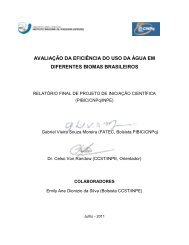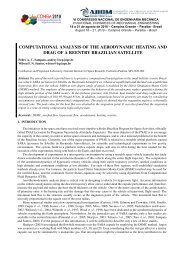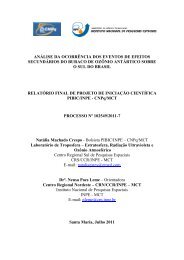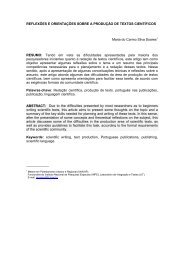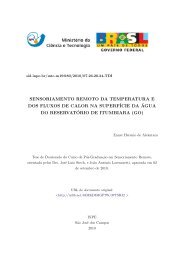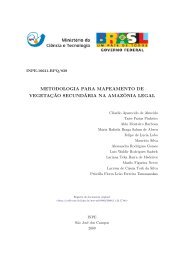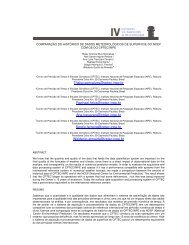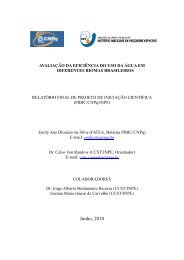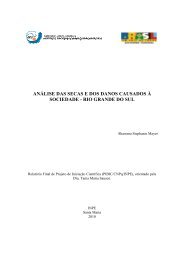Create successful ePaper yourself
Turn your PDF publications into a flip-book with our unique Google optimized e-Paper software.
THE ANALYSIS OF Nb 2 O 5 -DOPED ZrO 2 -TiO 2 CERAMIC AS SOIL WATER CONTENT<br />
SENSOR ELEMENT IN CONTROLLED ENVIRONMENTS<br />
R. M. Oliveira (1) ; M. C. A. Nono (1) and G. P. Britto Filho (2)<br />
(1) Laboratório Associado de Sensores e Materiais - LAS/INPE, São José dos Campos, SP.<br />
(2) Escola de Engenharia de Lorena - EEL/USP, Lorena, SP.<br />
Abstract: In this work, the behavior of ZrO 2 -TiO 2 porous ceramics doped with controlled<br />
percentages of Nb 2 O 5 for application as sensor elements of soil water content is presented. The<br />
goal of this research was to correlate the capacitance and impedance variation of the sensing<br />
elements, when immersed in soils previously selected, with the ceramic microstructure. The results<br />
obtained evidenced that the ZrO 2 -TiO 2 porous ceramics presented potential to be applied as sensor<br />
elements for soil moisture.<br />
Keywords: porous ceramics, sensor elements and soil moisture.<br />
1. Introduction<br />
Despite ceramic materials are known since thousands of years ago, their study in depth,<br />
however, is quite recent. Advanced ceramics, for its turn, present applications in several areas, from<br />
structural materials to electric ceramics and semiconductors. In this sense, the rapid evolution of the<br />
present market of automation and environmental parameters control has motivated the members of<br />
the Engineering and Science Group of Micro and Nanostructure Ceramics and Solid Surfaces<br />
(SUCERA) of the Space Researches National Institute (INPE) to search for new materials and<br />
improve measurements and signal processing techniques (Kuranaga; Nono; Silva and Mineiro,<br />
2004).<br />
1
The researchers of SUCERA have been working since 1997, on the development of ceramic<br />
materials, specifically metallic oxides, for application as relative humidity sensor elements and,<br />
since 2001, on the monitoring of soil water contents (Kuranaga; Nono; Silva and Mineiro, 2004 and<br />
Oliveira; Nono; Kuranaga and Mineiro, 2004). In this way, the development of ceramic sensing<br />
elements for soil water contents, proposed in this work, was based on studies on relative humidity<br />
sensing elements performed by the SUCERA Group, owing , mainly, to the similarity of the<br />
adsorption/ desorption mechanisms in both sensing elements. The water molecules adsorption<br />
features on the ceramic surfaces are the great responsible for changing in the electrical properties,<br />
allowing for the uses of these materials as humidity sensor elements, at whatever operation<br />
principle (Fagan and Amarakoon, 1993 and Yang and Wu, 1991). The understanding of the water<br />
adsorption mechanism on the surface of these solids makes possible the improvement of<br />
modifications on their microstructure and the suitable choice of their chemical compositions.<br />
Among the materials analyzed for humidity monitoring, the choice lay on ceramics, mainly due to<br />
their unique microstructure, consisting of grains, grain boundaries, surfaces and pores that favor the<br />
water movement in their interior, since they have a controlled porous microstructure and a suitable<br />
chemical composition (Shimizu; Arai and Seiyama, 1985 and Gusmano, et al., 1991). In this work,<br />
in so far as, a ZrO 2 -TiO 2 solid solution was used, doped with controlled percentages of Nb 2 O 5, to<br />
promote the increasing of active sites on sensing surfaces, and, consequently, to generate higher<br />
reliability on the ceramic sensors responses in water molecules quantification for several kinds of<br />
soils (Bueno, et al., 1996).<br />
It deals about a subject of great originality in world-wide terms, mainly concerning to the<br />
influence of the shape and of the size distribution of pores in the capacity of chemical and physical<br />
interaction of water molecules with the sensor material surface.<br />
2
1.1 Water molecules adsorption mechanisms on ceramic faces<br />
The humidity ceramic sensing elements, when exposed to humid environments, allow the<br />
water molecules to pass freely through their microstructure for capillary action and wetting of the<br />
pore surfaces, starting a water adsorption process in the metallic oxides, and, consequently,<br />
monitoring the humidity when related to electrical measurements. The oxygen atoms in the water<br />
are electrostatically attracted by the ceramic surfaces metallic atoms, due to the oxygen dipole<br />
moment (δ-) and the non balanced forces on the solid surfaces, which bring about these surfaces to<br />
behave as Lewis acid (δ+). The metallic atoms on the solid surfaces attract the partial negative<br />
charge of the oxygen atoms of the water while repel the partial positive charge of the hydrogen<br />
atoms in the water molecule. On account of this, it is supposed that the water molecules<br />
agglomerate themselves around the metallic toms, with the oxygen atoms steering inward and the<br />
hydrogen atoms steering outward this new surface (Kulwicki, 1991). Next, the water molecules are<br />
chemically adsorbed in available sites of the metallic oxide surface, preferentially on crystal grain<br />
boundaries, through covalent bonds between the oxygen of the water and the metal of the ceramic<br />
surface. In this case, the water molecules behave themselves as a base of Lewis, since they donate a<br />
pair of electrons to surfaces of metallic oxides, that, for their turn, behave themselves as a Lewis<br />
acid(as previously mentioned) receiving that pair of electrons (Atkins and Jones, 2006). In the<br />
moment that a covalent bond occurs between the metal and the oxygen, the O-H bond of the water<br />
molecule is broken, in order to recovery one electron, since in M-O bond formation, the oxygen<br />
gives one electron, thus acquiring a positive charge. Through this dissociative mechanism, two<br />
hydroxyl ions (OH - ) are formed for each water molecule. In each water molecule, the hydroxyl<br />
group (-OH) is adsorbed on the metal present in the surface layer of the grains, which have a high<br />
local charge density in a strong electrostatic field and the proton is added to the oxygen atom of the<br />
surface of the nearby metallic oxides, to form a second group -OH. The chemically adsorbed layer,<br />
once formed, in not affected any more by the humidity exposure.<br />
3
When the layer of chemisorbed hydroxyls is formed, the subsequent water molecules layers<br />
are chemisorbed by it, as well, through hydrogen bonds. The physisorbed water easily dissociates<br />
itself to form a hydroniun (H 3 O + ) on account of the high electrostatic fields in the chemisorbed<br />
layer. The first physisorbed water molecules layer is characterized by the double hydrogen bond of<br />
a simple water molecule. The physisorbed monolayer easily changes to multilayer as the water<br />
amount adsorbed by the sensing element porous microstructure increases. The water molecules in<br />
the succeeding layers are just lonely bonded and present a liquid behavior. On account of this, the<br />
water molecules lonely bonded are able to form dipoles and re-orientate themselves freely, under an<br />
electrical field externally applied, resulting in the increase of the dielectric constant (Kulwicki,<br />
1991).<br />
2. Experimental Procedure<br />
The ceramic specimens used as sensing elements were prepared from the mechanical<br />
mixture of commercial powder in the ratio of 1:1 of ZrO 2 and TiO 2 (in weight) and doped with 1, 5,<br />
10, 15 and 20 % of Nb 2 O 5 . After the mixture preparation, the material was uniaxially compressed,<br />
to a pressure of 100 MPa in steel matrix, in the form of tablets, the dimensions of which being 2<br />
mm of thickness and 10 mm of diameter. The tablets had been sintered in the temperature of 1100<br />
ºC for approximately 2 hours in oven type chamber. A silver layer was deposited in the two sides of<br />
the ceramic tablet, serving as electrode to create the capacitive effect of the sensor. The<br />
characterizations of the ceramics were carried out using measurements of scanning electron<br />
microscopy (microscope - SEM, LEO 400) and X-ray diffraction (conventional diffractometer<br />
PHILIPS - 1840). The porous ceramic characterization as soil moisture sensor element was<br />
accomplished through capacitance and impedance measures using a RLC bridge (FLUKE-<br />
PM6304). The ceramic sensor was immersed in the selected soil, previously characterized as nonplastic<br />
soil, in which were added, in 9 steps of 24 hours each, fractions of the deionized water in<br />
4
quantity of 3.45 g, that corresponds to 11.13 % of the total soil drying mass, until to reach the soil<br />
saturation point (liquidity limit). At every 24 hours the capacitance and the impedance values were<br />
measured. These measurements were carried out at 40 o C and 90 % relative humidity, in order to<br />
simulate actual climatic conditions underwent by the soil at countryside.<br />
3. Results and Discussion<br />
In this work, ZrO 2 -TiO 2 ceramic tablets, doped with 1, 5, 10, 15 and 20 % of Nb 2 O 5 ,<br />
sintered at 1100 o C, were characterized through x-ray diffraction and scanning electron microscopy<br />
techniques. As electrical characterization of these ceramic elements, capacitance measurements in<br />
function of growing water content in a sandy clay type soil, under climatic conditions of<br />
temperature and relative humidity, were performed.<br />
The x-ray patterns in Fig. 1, show the presence of typical peaks of monoclinic phase ZrO 2 ,<br />
tetragonal phase TiO 2 and monoclinic phase Nb 2 O 5 . The characteristic peaks of Nb 2 O 5 were getting<br />
more and more defined as its added percentages increased. At 20 % of Nb 2 O 5 , peaks presented<br />
higher intensity in comparison to peaks of sample with 1 % of Nb 2 O 5 . However, concerning to ZrO 2<br />
and TiO 2 characteristic peaks, their intensity remained practically constant, in all samples.<br />
5
Z = ZrO 2<br />
T<br />
T = TiO 2<br />
Intensity (a.u.)<br />
N<br />
Z<br />
NN<br />
Z<br />
T<br />
Z N<br />
Z<br />
T<br />
Z<br />
Z<br />
N<br />
T<br />
Z<br />
Z<br />
N<br />
Z<br />
N<br />
Z<br />
NZ<br />
Z<br />
N Z<br />
Z<br />
NZ<br />
T<br />
T<br />
T<br />
T<br />
Z<br />
Z<br />
Z<br />
Z<br />
TZ<br />
TZ<br />
TZ<br />
TZ<br />
Z<br />
Z<br />
Z<br />
Z<br />
N<br />
N<br />
N<br />
N<br />
T<br />
T<br />
T<br />
T<br />
N = Nb 2<br />
O 5<br />
20 %<br />
15 %<br />
10 %<br />
5 %<br />
T<br />
Z<br />
Z<br />
N<br />
Z<br />
NZ<br />
T<br />
Z<br />
TZ<br />
Z<br />
N<br />
T<br />
1 %<br />
20 30 40 50 60 70 <strong>80</strong><br />
2 θ (degree)<br />
Figure 1. X-ray patterns of ZrO 2 –TiO 2 ceramics tablets, doped with 1, 5, 10, 15 and 20 % of<br />
Nb 2 O 5 , sintered at 1100 o C.<br />
In Fig. 2, it is observed the presence of pores in the microstructure of the ZrO 2 -TiO 2 ceramic<br />
tablets, doped with controlled percentages of Nb 2 O 5 . The porous microstructure formed in the<br />
process is necessary, according to the consulted technical literature, to allow the water to pass freely<br />
and the condensation of its molecules in the capillarity of the pores between the grains surfaces.<br />
a) b)<br />
6
c) d)<br />
Figure 2. SE micrographs. Fracture surfaces of ZrO 2 - TiO 2 sensors elements doped with: a) 1, b) 5,<br />
c) 10, d) 15 and e) 20 % of Nb 2 O 5 , sintered at 1100 o C.<br />
e)<br />
The capacitance measurements, in function of increasing water content, obtained with<br />
ceramic sensor in a sample of sandy clay type soil, up to its saturation, indicate a near approach to<br />
linear behavior, in agreement with the consulted literature (Fig. 3). In this sense, one can observe,<br />
for instance, that the sensor element doped with 5 % of Nb 2 O 5 presented a correlation coefficient<br />
equal to 0.95306 (Fig. 3b), near to 1, and, on the other hand, the sensor element doped with 10% of,<br />
presented a coefficient equal to 0.65775 (Fig. 3c). In so far as, the sensor element doped with 5 %<br />
of Nb 2 O 5 presented the highest sensitivity to water, followed by the other sensor elements, namely,<br />
7
doped with 20 % of Nb 2 O 5 (0.93988) (Fig. 3e), with 15 % of Nb 2 O 5 (0.84341) (Fig. 3d), with 1 %<br />
of Nb 2 O 5 (0.71611) (Fig. 3a) and at last, with 10 % of Nb 2 O 5 (0.65775) (Fig. 3c). The climatic<br />
conditions of temperature (40 o C) and relative humidity (90 %), influenced the saturation of the<br />
sample of the sandy clay type soil, for, initially, 7 capacitance measurements were proposed up to<br />
the soil saturation, but, afterwards, it is noticed that 10 measurements were performed up to the soil<br />
saturation. Consequently, the ceramic sensor elements responded in a coherent way, even with the<br />
soil saturation delay owing to the simulated climatic conditions.<br />
1 % Nb 2<br />
O 5<br />
5 % Nb 2<br />
O 5<br />
1E-9<br />
Capacitance (F)<br />
1E-10<br />
1E-11<br />
Correlation Coefficient: 0.71611<br />
Capacitance (F)<br />
1E-10<br />
Correlation Coefficient: 0.95306<br />
0 5 10 15 20 25 30<br />
Soil water content (%)<br />
0 5 10 15 20 25 30<br />
Soil water content (%)<br />
a) b)<br />
10 % Nb 2<br />
O 5<br />
15 % Nb 2<br />
O 5<br />
Capacitance (F)<br />
1E-10<br />
Correlation Coefficient: 0.65775<br />
Capacitance (F)<br />
1E-10<br />
Correlation Coefficient: 0.84341<br />
0 5 10 15 20 25 30<br />
0 5 10 15 20 25 30<br />
Soil water content (%)<br />
Soil water content (%)<br />
c) d)<br />
8
20 % Nb 2<br />
O 5<br />
Capacitance (F)<br />
1E-10<br />
Correlation Coefficient: 0.93988<br />
0 5 10 15 20 25 30<br />
Soil water content (%)<br />
e)<br />
Figure 3. Capacitance measurements of the ZrO 2 - TiO 2 ceramic sensor elements doped with a) 1, b)<br />
5, c) 10, d) 15 and e) 20 % of, sintered at 1100 o C, under climatic conditions of 40 o C and<br />
relative humidity 90 %.<br />
4. Conclusion<br />
According to the x-ray spectra, the ceramic sensing elements are composed by three distinct<br />
crystalline phases, namely, ZrO 2 , TiO 2 and Nb 2 O 5 forming a ZrO 2 -TiO 2 solid solution, with<br />
controlled additions of Nb 2 O 5 . The ceramic processing used to fabricate the ceramic tablets made<br />
possible the formation of a porous microstructure more suitable to be applied as ceramic sensor, due<br />
to the agglomeration of particles and their subsequent coalescence. The ZrO 2 - TiO 2 sensor element<br />
doped with 5 % of Nb 2 O 5 , presented the best response to water contents.<br />
5. References<br />
Atkins, P. E. and Jones, L.; Princípios de Química – Questionando a Vida Moderna e o Meio<br />
Ambiente. Tradução Ricardo Bicca de Alencastro. - 3ª Edição – Porto Alegre: Bookman,<br />
2006.<br />
9
Bueno, P. R.; Camargo, E.; Longo, E.; Leite, E.; Pianaro, S. A.; Varela, J. A.. J. Mat. Sci. Lett. 15<br />
(1996) 2048.<br />
Fagan, J. G. and Amarakoon, V. R. W.; “Humidity Sensors”, Am. Cer. Soc. Bull. 72(3), 119,<br />
(1993).<br />
Gusmano, G.; Montesperelli, P.; Nunziante and Traversa. E., Influence of the powder synthesis<br />
process on the a.c. impedance response of MgAl 2 O 4 spinel pellets at different environmental<br />
humidities, in S.I. Hirano, G. L. Messing and H. Hausner (eds.), Ceram Transactions, Vol.<br />
22, Ceramic Powder Science IV, Am. Ceram. Soc. , Westerville, USA, 1991, pp. 545-551<br />
Kulwicki, B. M. Humidity sensors. J. Am. Ceram. Soc., 74 (1991) 697-708.<br />
Kuranaga, C.; Nono, M. C. A.; Silva, M. D.; Mineiro. Influence of porous microstructure on<br />
humidity sensing properties of ZrO 2 -TiO 2 ceramics. In: III Encontro da SBPMat - Brazilian<br />
MRS Meeting 2004, Foz do Iguaçu/PR. Anais..., 2004.<br />
Oliveira, R. M.; Nono, M. C. A.; Kuranaga, C. ; Mineiro, S. L. Development of ZrO 2 -TiO 2 ceramic<br />
as soil humidity sensor for application in environmental monitoring. In: III Encontro da<br />
SBPMat – Brazilian MRS Meeting 2004, Foz do Iguaçu/PR, Anais..., 2004.<br />
Shimizu, Y.; Arai, H. and Seiyama, T., Theoretical studies on the impedance-humidity<br />
characteristics of ceramic humidity sensors, Sensors and Actuators, 7 (1985) 11-22.<br />
Yang, S. and Wu, J; “Ceramic Humidity Sensors”, J. Mater Sci. 26, 631, (1991).<br />
10



